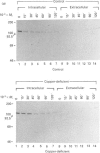Abstract
To examine the mechanisms of holo-caeruloplasmin biosynthesis, we measured the serum caeruloplasmin concentration and oxidase activity, hepatic caeruloplasmin mRNA content and hepatocyte caeruloplasmin biosynthesis and secretion in normal and copper-deficient rats. Copper deficiency resulted in a near-complete loss of serum caeruloplasmin oxidase activity, yet only a 60% reduction in serum caeruloplasmin concentration and no change in the abundance of hepatic caeruloplasmin mRNA or the rate of caeruloplasmin biosynthesis. Both interleukin-1 alpha and lipopolysaccharide increased hepatic caeruloplasmin mRNA content and caeruloplasmin biosynthesis in normal and copper-deficient animals, but neither mediator increased caeruloplasmin oxidase activity in the copper-deficient group. Pulse-chase studies in primary hepatocytes from normal and copper-deficient rats revealed that the secretory rates for newly synthesized caeruloplasmin were identical, despite little or no holo-caeruloplasmin synthesis in hepatocytes of copper-deficient rats. We conclude that hepatocyte copper content has no effect on hepatic caeruloplasmin-gene expression or caeruloplasmin biosynthesis and that the incorporation of copper into newly synthesized caeruloplasmin is not a rate-limiting step in the biosynthesis or secretion of the apoprotein from rat hepatocytes.
Full text
PDF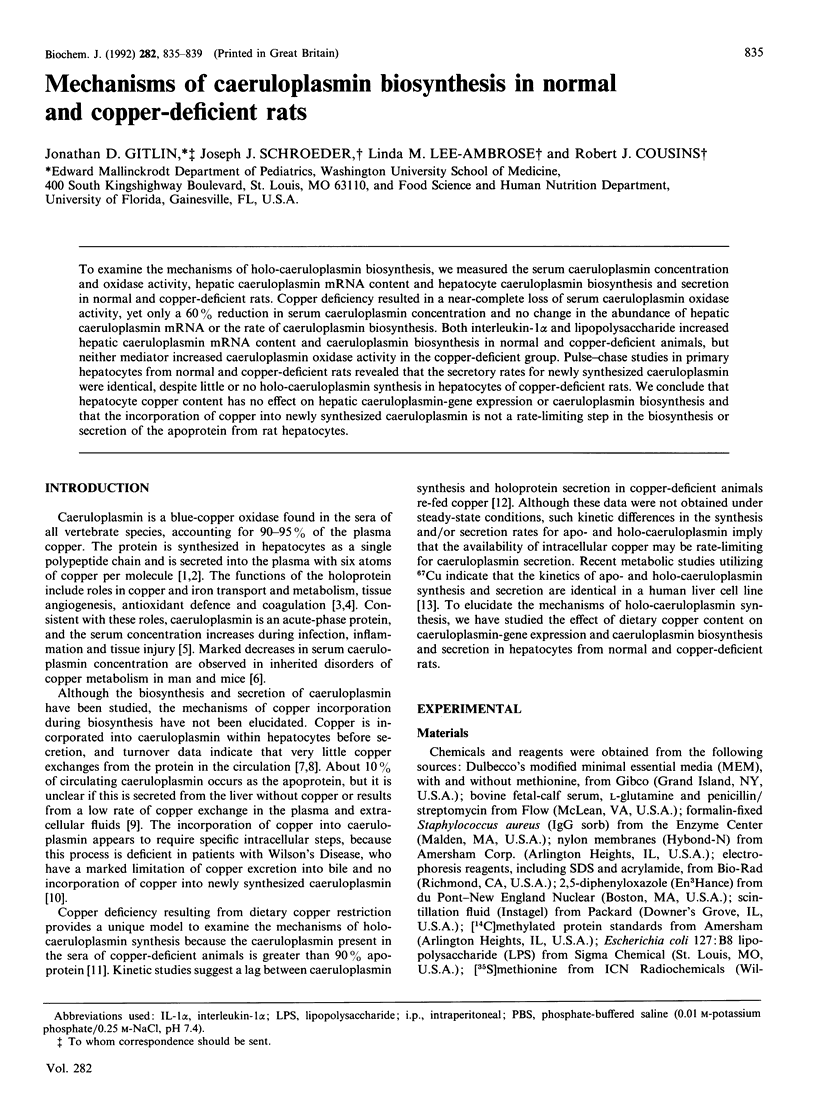
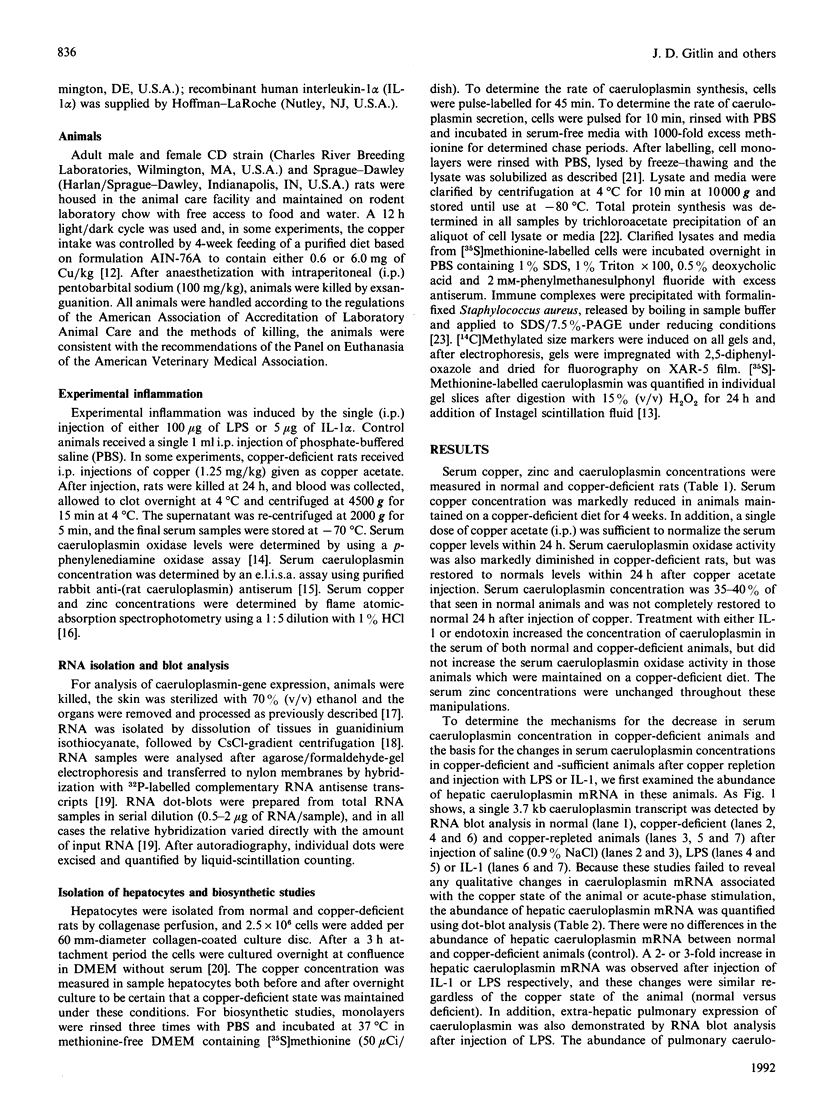
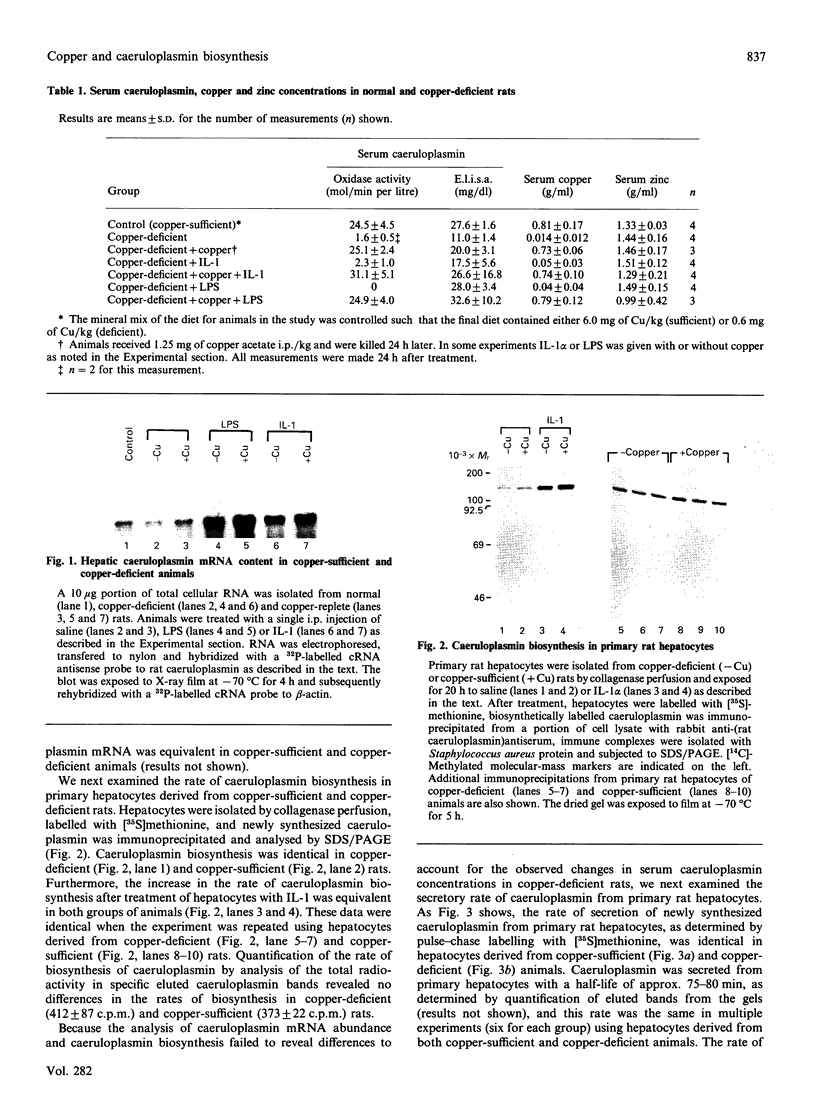
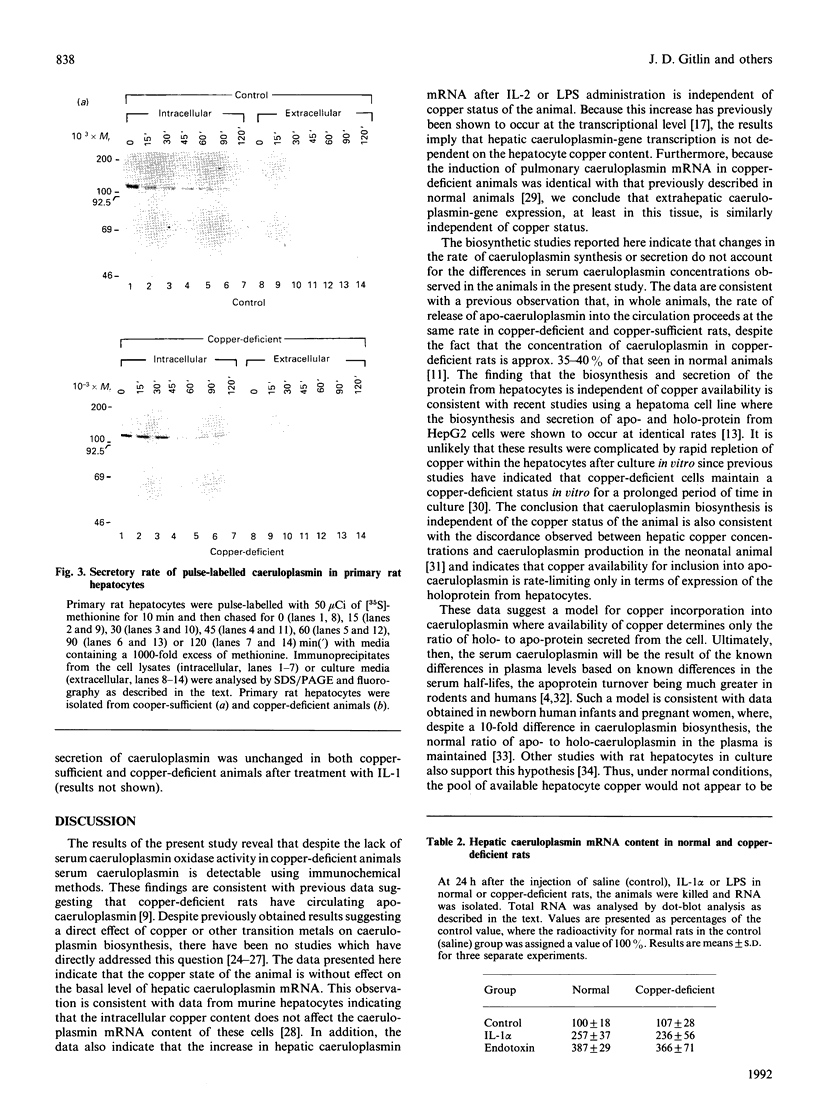
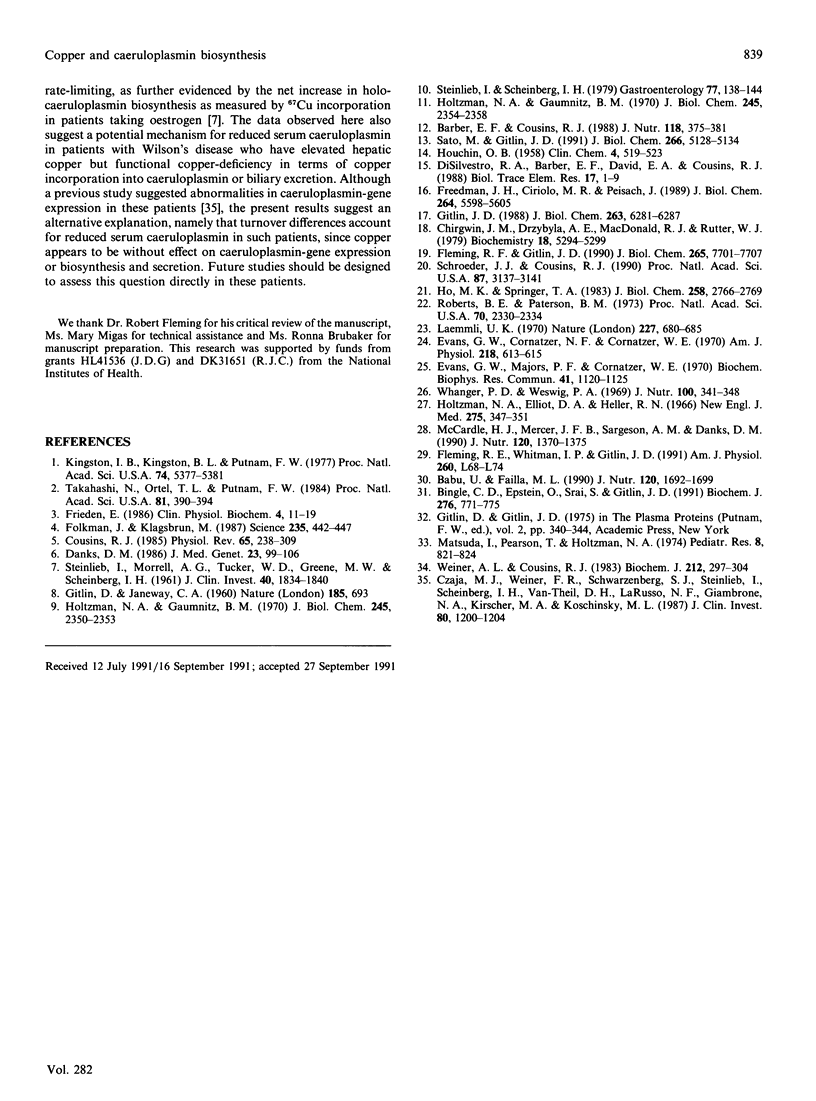
Images in this article
Selected References
These references are in PubMed. This may not be the complete list of references from this article.
- Babu U., Failla M. L. Respiratory burst and candidacidal activity of peritoneal macrophages are impaired in copper-deficient rats. J Nutr. 1990 Dec;120(12):1692–1699. doi: 10.1093/jn/120.12.1692. [DOI] [PubMed] [Google Scholar]
- Barber E. F., Cousins R. J. Interleukin-1--stimulated induction of ceruloplasmin synthesis in normal and copper-deficient rats. J Nutr. 1988 Mar;118(3):375–381. doi: 10.1093/jn/118.3.375. [DOI] [PubMed] [Google Scholar]
- Bingle C. D., Epstein O., Srai S. K., Gitlin J. D. Hepatic caeruloplasmin-gene expression during development in the guinea-pig. Correlation with changes in hepatic copper metabolism. Biochem J. 1991 Jun 15;276(Pt 3):771–775. doi: 10.1042/bj2760771. [DOI] [PMC free article] [PubMed] [Google Scholar]
- Chirgwin J. M., Przybyla A. E., MacDonald R. J., Rutter W. J. Isolation of biologically active ribonucleic acid from sources enriched in ribonuclease. Biochemistry. 1979 Nov 27;18(24):5294–5299. doi: 10.1021/bi00591a005. [DOI] [PubMed] [Google Scholar]
- Cousins R. J. Absorption, transport, and hepatic metabolism of copper and zinc: special reference to metallothionein and ceruloplasmin. Physiol Rev. 1985 Apr;65(2):238–309. doi: 10.1152/physrev.1985.65.2.238. [DOI] [PubMed] [Google Scholar]
- Czaja M. J., Weiner F. R., Schwarzenberg S. J., Sternlieb I., Scheinberg I. H., Van Thiel D. H., LaRusso N. F., Giambrone M. A., Kirschner R., Koschinsky M. L. Molecular studies of ceruloplasmin deficiency in Wilson's disease. J Clin Invest. 1987 Oct;80(4):1200–1204. doi: 10.1172/JCI113180. [DOI] [PMC free article] [PubMed] [Google Scholar]
- Danks D. M. Of mice and men, metals and mutations. J Med Genet. 1986 Apr;23(2):99–106. doi: 10.1136/jmg.23.2.99. [DOI] [PMC free article] [PubMed] [Google Scholar]
- DiSilvestro R. A., Barber E. F., David E. A., Cousins R. J. An enzyme-linked immunoadsorbent assay for rat ceruloplasmin. Biol Trace Elem Res. 1988 Sep-Dec;17:1–9. doi: 10.1007/BF02795442. [DOI] [PubMed] [Google Scholar]
- Evans GW MAJORS P. F., Cornatzer W. E. Induction of ceruloplasmin synthesis by copper. Biochem Biophys Res Commun. 1970 Dec 9;41(5):1120–1125. doi: 10.1016/0006-291x(70)90201-9. [DOI] [PubMed] [Google Scholar]
- Evans G. W., Cornatzer N. F., Cornatzer W. E. Mechanism for hormone-induced alterations in serum ceruloplasmin. Am J Physiol. 1970 Mar;218(3):613–615. doi: 10.1152/ajplegacy.1970.218.3.613. [DOI] [PubMed] [Google Scholar]
- Fleming R. E., Gitlin J. D. Primary structure of rat ceruloplasmin and analysis of tissue-specific gene expression during development. J Biol Chem. 1990 May 5;265(13):7701–7707. [PubMed] [Google Scholar]
- Fleming R. E., Whitman I. P., Gitlin J. D. Induction of ceruloplasmin gene expression in rat lung during inflammation and hyperoxia. Am J Physiol. 1991 Feb;260(2 Pt 1):L68–L74. doi: 10.1152/ajplung.1991.260.2.L68. [DOI] [PubMed] [Google Scholar]
- Folkman J., Klagsbrun M. Angiogenic factors. Science. 1987 Jan 23;235(4787):442–447. doi: 10.1126/science.2432664. [DOI] [PubMed] [Google Scholar]
- Freedman J. H., Ciriolo M. R., Peisach J. The role of glutathione in copper metabolism and toxicity. J Biol Chem. 1989 Apr 5;264(10):5598–5605. [PubMed] [Google Scholar]
- Frieden E. Perspectives on copper biochemistry. Clin Physiol Biochem. 1986;4(1):11–19. [PubMed] [Google Scholar]
- GITLIN D., JANEWAY C. A. Turnover of the copper and protein moieties of ceruloplasmin. Nature. 1960 Mar 5;185:693–693. doi: 10.1038/185693a0. [DOI] [PubMed] [Google Scholar]
- Gitlin J. D. Transcriptional regulation of ceruloplasmin gene expression during inflammation. J Biol Chem. 1988 May 5;263(13):6281–6287. [PubMed] [Google Scholar]
- HOUCHIN O. B. A rapid colorimetric method for the quantitative determination of copper oxidase activity (ceruloplasmin). Clin Chem. 1958 Dec;4(6):519–523. [PubMed] [Google Scholar]
- Ho M. K., Springer T. A. Biosynthesis and assembly of the alpha and beta subunits of Mac-1, a macrophage glycoprotein associated with complement receptor function. J Biol Chem. 1983 Mar 10;258(5):2766–2769. [PubMed] [Google Scholar]
- Holtzman N. A., Elliott D. A., Heller R. H. Copper intoxication. Report of a case with observations on ceruloplasmin. N Engl J Med. 1966 Aug 18;275(7):347–352. doi: 10.1056/NEJM196608182750702. [DOI] [PubMed] [Google Scholar]
- Holtzman N. A., Gaumnitz B. M. Identification of an apoceruloplasmin-like substance in the plasma of copper-deficient rats. J Biol Chem. 1970 May 10;245(9):2350–2353. [PubMed] [Google Scholar]
- Holtzman N. A., Gaumnitz B. M. Studies on the rate of release and turnover of ceruloplasmin and apoceruloplasmin in rat plasma. J Biol Chem. 1970 May 10;245(9):2354–2358. [PubMed] [Google Scholar]
- Kingston I. B., Kingston B. L., Putnam F. W. Chemical evidence that proteolytic cleavage causes the heterogeneity present in human ceruloplasmin preparations. Proc Natl Acad Sci U S A. 1977 Dec;74(12):5377–5381. doi: 10.1073/pnas.74.12.5377. [DOI] [PMC free article] [PubMed] [Google Scholar]
- Laemmli U. K. Cleavage of structural proteins during the assembly of the head of bacteriophage T4. Nature. 1970 Aug 15;227(5259):680–685. doi: 10.1038/227680a0. [DOI] [PubMed] [Google Scholar]
- Matsuda I., Pearson T., Holtzman N. A. Determination of apoceruloplasmin by radioimmunoassay in nutritional copper deficiency, Menkes' kinky hair syndrome, Wilson's disease, and umbilical cord blood. Pediatr Res. 1974 Oct;8(10):821–824. doi: 10.1203/00006450-197410000-00001. [DOI] [PubMed] [Google Scholar]
- McArdle H. J., Mercer J. F., Sargeson A. M., Danks D. M. Effects of cellular copper content on copper uptake and metallothionein and ceruloplasmin mRNA levels in mouse hepatocytes. J Nutr. 1990 Nov;120(11):1370–1375. doi: 10.1093/jn/120.11.1370. [DOI] [PubMed] [Google Scholar]
- Roberts B. E., Paterson B. M. Efficient translation of tobacco mosaic virus RNA and rabbit globin 9S RNA in a cell-free system from commercial wheat germ. Proc Natl Acad Sci U S A. 1973 Aug;70(8):2330–2334. doi: 10.1073/pnas.70.8.2330. [DOI] [PMC free article] [PubMed] [Google Scholar]
- Sato M., Gitlin J. D. Mechanisms of copper incorporation during the biosynthesis of human ceruloplasmin. J Biol Chem. 1991 Mar 15;266(8):5128–5134. [PubMed] [Google Scholar]
- Schroeder J. J., Cousins R. J. Interleukin 6 regulates metallothionein gene expression and zinc metabolism in hepatocyte monolayer cultures. Proc Natl Acad Sci U S A. 1990 Apr;87(8):3137–3141. doi: 10.1073/pnas.87.8.3137. [DOI] [PMC free article] [PubMed] [Google Scholar]
- Sternlieb I., Morell A. G., Tucker W. D., Greene M. W., Scheinberg I. H. THE INCORPORATION OF COPPER INTO CERULOPLASMIN IN VIVO: STUDIES WITH COPPER AND COPPER. J Clin Invest. 1961 Oct;40(10):1834–1840. doi: 10.1172/JCI104407. [DOI] [PMC free article] [PubMed] [Google Scholar]
- Sternlieb I., Scheinberg I. H. The role of radiocopper in the diagnosis of Wilson's disease. Gastroenterology. 1979 Jul;77(1):138–142. [PubMed] [Google Scholar]
- Takahashi N., Ortel T. L., Putnam F. W. Single-chain structure of human ceruloplasmin: the complete amino acid sequence of the whole molecule. Proc Natl Acad Sci U S A. 1984 Jan;81(2):390–394. doi: 10.1073/pnas.81.2.390. [DOI] [PMC free article] [PubMed] [Google Scholar]
- Weiner A. L., Cousins R. J. Hormonally produced changes in caeruloplasmin synthesis and secretion in primary cultured rat hepatocytes. Relationship to hepatic copper metabolism. Biochem J. 1983 May 15;212(2):297–304. doi: 10.1042/bj2120297. [DOI] [PMC free article] [PubMed] [Google Scholar]
- Whanger P. D., Weswig P. H. Effect of some copper antagonists on induction of ceruloplasmin in the rat. J Nutr. 1970 Mar;100(3):341–348. doi: 10.1093/jn/100.3.341. [DOI] [PubMed] [Google Scholar]





